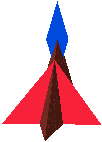Suggestions for Researchers
There are two aspects of the game that make it easy to rework it into a test test bed for the exploration of scientific questions:
- When you hit F2 during the game, 3D rendering is switched off, while the game keeps running, and information is still being displayed. It would be very easy to build on this to display any kind of information about what is going on in the game world. Since the program writes to files a lot, it would also be a simple programming task to save all kinds of information to log files. The switch from a 3D-view of the world to a data-analysis interface could be done with one hit of a button, while data-gathering would go on continuously.
- By using the cheat code the player can get unlimited invisibility time. In more scientific terms this means that there is already a mechanism to remove the "player" from the game world and turn him into nothing more than a maneuverable camera. Since the game can have any number of "players", it is possible to have a camera into the game world and an arbitrary number of "players", who could then be turned into a 4th species which is antagonistic to the 3 species already in the game. This would constitute a situation wherein arms-races between "monsters" and "players" could be set up and monitored.
Once the program has been modified into a scientific test bed, where player 0 is a moveable camera, and players 1, ... ,n are members of a fourth species, it would be necessary to write a new behavior algorithm for the fourth species that allows for evolutionary change of behavior. Then, arms-races between species 4 and the three co-operating species could be set up and monitored with respect to any scientific question one might want to explore. We believe that this project would make a good subject for a Master's thesis that could be expanded upon into a doctoral dissertation (where the focus would be on the rigorous exploration of some hypothesis in the field of artificial life).
If a scientific test bed version of bSerene were available, a number
of very interesting possibilities would open up: It would be possible to teach a course on artificial life or artificial intelligence during which (groups of) students would compete in trying to write the most efficient behavior algorithm for species 4, thus introducing species 5, 6,..., who would compete with each other in long runs of the test bed world. Other people could write fancier versions of the behavior algorithms for the three co-operating species, implementing things such as memory, site maps, and neural net processing, thus launching an intellectual arms race between groups of students/researchers, where the outcome of the arms race in the test bed world would decide who had written the best algorithm. This would constitute an objective way to find the best AI programs for these types of agents.
While the 3D-rendering of the world is quite irrelevant for the execution of scientific research, we believe that the sensual immersion it offers is the optimal medium for forming preliminary intuitive insights from which new scientific questions and approaches can arise. Also, it makes a research project fun if you can slip into the world and view it from the perspective of its inhabitants. Last but not least, we believe that a rigorous exploration of the most efficient types of behavior algorithms for these kinds of agents would open up good job prospects in the world of game programming and beyond.



